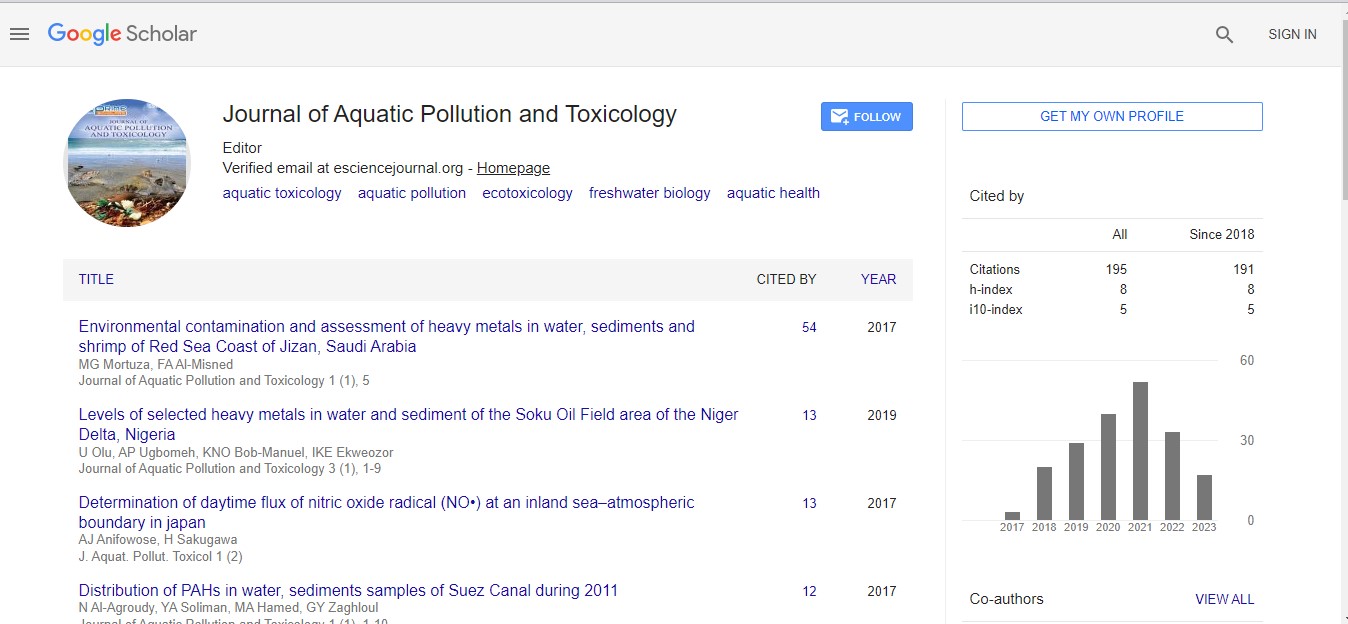Short Communication - (2024) Volume 8, Issue 1
Exploring the Microscopic Plankton Beauty of Aquatic Environments
Debra Warburton*
Department of Aquatic Pollution, Cornell University, USA
*Correspondence:
Debra Warburton,
Department of Aquatic Pollution, Cornell University,
USA,
Email:
Received: 28-Feb-2024, Manuscript No. IPJAPT-24-19336;
Editor assigned: 01-Mar-2024, Pre QC No. IPJAPT-24-19336 (PQ);
Reviewed: 15-Mar-2024, QC No. IPJAPT-24-19336;
Revised: 20-Mar-2024, Manuscript No. IPJAPT-24-19336 (R);
Published:
27-Mar-2024, DOI: 10.21767/2581-804X-8.1.01
Introduction
Aquatic environments encompass a vast and diverse realm
that covers approximately 71% of the Earth’s surface. From the
depths of the ocean abyss to the tranquil streams of freshwater
rivers, these ecosystems are not only home to an astonishing
array of life but also play a vital role in maintaining the balance
of our planet’s ecosystems. However, despite their importance,
aquatic environments face numerous threats that jeopardize
their fragile beauty and the myriad of species that call them
home. One of the most striking aspects of aquatic environments
is their incredible biodiversity. From to the majestic blue whale,
these ecosystems support a staggering variety of life forms.
Coral reefs, often referred to as the rainforests of the sea are
among the most biodiverse habitats on the planet, providing
a home for countless species of fish, invertebrates, and other
marine organisms [1,2].
Description
Mangrove forests, found in coastal regions around the world,
serve as nurseries for fish and provide essential habitat for
birds and other wildlife. However, this biodiversity is under
threat from a range of human activities. Pollution, overfishing,
habitat destruction, and climate change are just some of the
factors contributing to the decline of aquatic ecosystems
worldwide. Plastic pollution, in particular, poses a significant
threat to marine life, with millions of tons of plastic waste
entering the oceans each year. This waste not only harms
marine animals through ingestion and entanglement but also
degrades water quality and disrupts fragile marine ecosystems.
Overfishing is another major concern, with many fish stocks
being depleted due to unsustainable fishing practices. The loss
of key species can have far-reaching consequences for marine
ecosystems, disrupting food webs and altering the balance of
entire ecosystems. Illegal, unreported, and unregulated fishing
exacerbate this problem, making it difficult to manage and
conserve marine resources effectively. Habitat destruction
is also a significant threat to aquatic environments. Coastal
development, dredging, and the destruction of mangroves and
wetlands for agriculture and urbanization have led to the loss
of critical habitat for many species. Coral reefs, in particular,
are highly vulnerable to habitat degradation, with factors such
as pollution, sedimentation, and ocean acidification posing
significant threats to their survival. Climate change further
compounds these challenges, with rising temperatures, ocean
acidification, and sea-level rise posing unprecedented risks to
aquatic ecosystems. Coral bleaching events, driven by increased
water temperatures, have devastated coral reefs around the
world, leading to widespread coral mortality and the loss of
biodiversity. Sea-level rise threatens coastal habitats, such as
mangroves and salt marshes, while changes in ocean chemistry
affect the health of marine organisms, particularly those with
calcium carbonate shells, such as corals and shellfish. Despite
these challenges, there is hope for the future of aquatic
environments [3,4].
Conclusion
Conservation efforts such as marine protected areas,
sustainable fisheries management, and initiatives to reduce
pollution, are helping to mitigate some of the threats facing
these ecosystems. Public awareness and education play a crucial
role in fostering a greater understanding of the importance of
aquatic environments and the need to protect them for future
generations. In conclusion, aquatic environments are invaluable
ecosystems that support a vast array of life and play a vital role
in maintaining the health of our planet. However, they face
numerous threats from human activities, including pollution,
overfishing, habitat destruction, and climate change. By taking
action to address these threats and promote conservation
efforts, we can work towards safeguarding the fragile beauty
of aquatic environments and ensuring their continued survival
for generations to come.
Acknowledgement
None.
Conflict Of Interest
The author declares there is no conflict of interest in publishing
this article.
References
- Cermeno P, Choucino P, Fernandez CB, Figueiras FG, Maranon E, et al. (2016) Marine primary productivity is driven by a selection effect. Front Mar Sci 3(1): 173.
[Crossref] [Google Scholar]
- Finlay BJ (2002) Global dispersal of free-living microbial eukaryote species. Science 296(5570): 1061-1063.
[Crossref] [Google Scholar]
- Grover JP, Chrzanowski TH (2004) Limiting resources, disturbance, and diversity in phytoplankton communities. Ecol Monogr 74(3): 533-551.
[Crossref] [Google Scholar]
- Litchman E, Klausmeier CA (2008) Trait-based community ecology of phytoplankton. Annu Rev Ecol Evol Syst 39(5): 615-639.
[Crossref] [Google Scholar]
Citation: Warburton D (2024) Exploring the Microscopic Plankton Beauty of Aquatic Environments. J Aquat Pollut Toxicol. 8:01.
Copyright: © 2024 Warburton D. This is an open-access article distributed under the terms of the Creative Commons Attribution License, which permits unrestricted use, distribution, and reproduction in any medium, provided the original author and source are credited.

